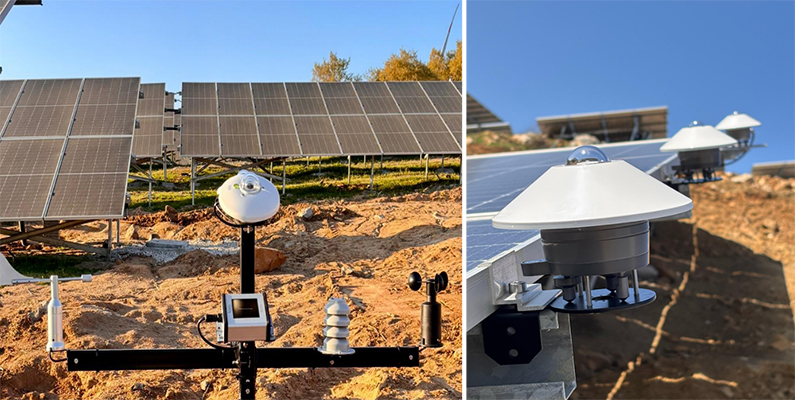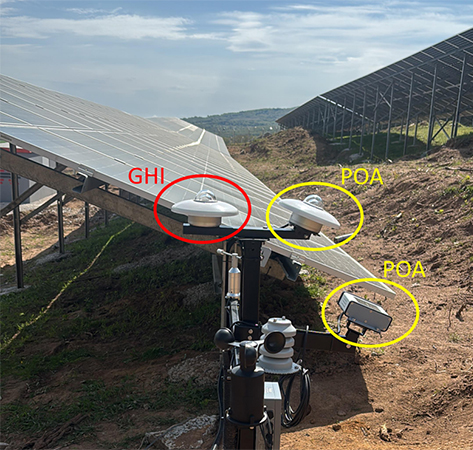
Understanding how sunlight is measured for evaluating and monitoring the Photovoltaic (PV) Systems is a very important task. For this, in this simple guide, we’ll break down the types of solar irradiance (POA, GHI, DHI, and DNI) what each type means how they are measured, and which devices to use.
What Is Solar Irradiance?
Solar irradiance means the amount of sunlight that hits a surface, usually measured in watts per square meter (W/m²).
In solar power, we need to measure sunlight to see how much energy our panels can produce. There are four main types of solar irradiance used in PV solar monitoring:
- POA (Plane of Array)
- GHI (Global Horizontal Irradiance)
- DHI (Diffuse Horizontal Irradiance)
- DNI (Direct Normal Irradiance)
We’ll discuss each of them and bring some real examples to simplify and understand them well.
POA Irradiance (Plane of Array)
POA irradiance is the total sunlight that hits the surface of your solar panels. It is very important because it tells you how much light the panels are getting in their actual position (tilt and direction).
In simple words, it can be considered as the sunlight your solar panels actually see and use.
What does it include?
- Direct sunlight (straight from the sun)
- Diffuse light (scattered from the sky)
- Reflected light (from the ground or surroundings)
Note: we shouldn’t mix between Diffuse light and DHI, because POA includes diffuse light, but not exactly the DHI measured on a flat surface, it’s the diffuse light as it falls onto the tilted panels.
How is it measured?
With a sensor mounted at the same tilt and direction as your panels. Usually, the sensors used are the PV reference cells, or PV Irradiance sensors because they are made of a miniature cell of solar panels and behave the same way as PV Solar panels and also have the same spectral response.

Irradiance sensor and Pyranometer for measuring POA
Why it matters: It helps calculate how much energy your panels should be producing. If POA is high but production is low, something’s wrong.
Here is a small example of how to calculate the POA Irradiance: Let’s consider a PV system with DNI= 800 W/m², DHI= 150 W/m², Solar Zenith Angle (θz): 40° and Angle of Incidence (θ): 20°
- Knowing that POA=DNI⋅cos(θ)
- POA =800⋅cos (20∘) =800⋅94
- So, POA=752 W/m2
GHI (Global Horizontal Irradiance)
GHI is the total sunlight falling on a flat surface (like the ground or a flat roof). It includes both:
- Direct sunlight
- Diffuse (scattered) light
How it’s measured:
With a sensor placed flat and horizontal. Here we can talk about the thermopile pyranometer, which is a device designed to measure solar radiation on a surface, and it is mounted flat and horizontal to capture all the sunlight falling on that surface.

Let’s calculate the GHI Irradiance Considering the same PV system with we used to calculate POA Irradiance, but this time we need DHI Irradiance and Solar Zenith Angle (θz) which are respectively 150 and 40°
- Knowing that GHI=DHI+DNI⋅cos(θz)
- GHI=150+800⋅cos (40∘) ≈150+800⋅766
- So, GHI = 762.8 W/m2
DHI (Diffuse Horizontal Irradiance)
DHI is the sunlight that’s scattered in the sky, not coming straight from the sun. In simple words, it measures the soft sunlight that reaches solar panels even when it’s cloudy or the sun is blocked, like the light that makes the sky glow even though the sun is not seen.
How is DHI measured?
It is measured by using a pyranometer, just like for GHI. BUT: It must be shaded so it blocks direct sunlight. This way, the sensor only measures diffuse (scattered) light coming from the sky.
DNI (Direct Normal Irradiance)
DNI is the sunlight that comes straight from the sun, like a focused flashlight beam. DNI tells us how strong the direct sunlight is when the sensor is pointed directly at the sun.
How is DNI measured?
It is measured by a special sensor called a pyrheliometer. The pyrheliometer is mounted on a solar tracker that constantly follows the sun’s position in the sky. It has a narrow field of view, so it only measures the direct beam from the sun and excludes all scattered light.
Note: A pyrheliometer is the only instrument that accurately measures DNI.
Practical calculation of DNI and DHI
Consider a PV system with the following measured values:
- GHI = 762.8 W/m2
- POA=752 W/m2
- Solar Zenith Angle (θz): 40°
- Angle of Incidence (θ): 20°
Calculation Formulas are:
- DNI=POA / cos(θ)
- DHI=GHI-DNI⋅cos(θz)
So;
DNI= 752/cos (20∘) => DNI≈800⋅0.94 W/m2
DHI = 762.8−800.26×cos (40∘) => DHI≈149.76W/m2
These quick calculations show how each type of sunlight, direct, diffuse, and reflected, works together to make up the total energy your solar panels receive.

Briefing Table
| Irradiance Type | Definition | Measurement Instrument | Orientation | IEC 61724-1:2021 Class A Requirement |
| POA Irradiance | Total irradiance on the PV module plane | Thermopile pyranometer Irradiance sensors or PV reference cells | Same tilt as panels | Required |
| GHI | Total irradiance on a horizontal surface | Thermopile pyranometer | Flat/horizontal | Required |
| DHI | Diffuse irradiance on a horizontal surface | Shaded thermopile pyranometer | Horizontal with shading device | Optional |
| DNI | Direct beam irradiance perpendicular to the sun | Pyrheliometer on solar tracker | Normal to sun | Optional |